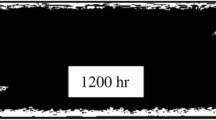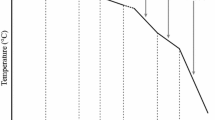Abstract
The applicability condition of the time–temperature superposition principle (TTSP) to a multi-phase system is analytically discussed assuming a mixture law. It was concluded that the TTSP does not hold for a multi-phase system in general but does hold for a multi-component system in which some components have the same temperature dependence and the others have no temperature dependence. On the basis of the results, the application of the TTSP to plant materials such as wood and bamboo was examined using a mixture law and a stretched-exponential function having a characteristic relaxation time τ 0 and a stretching parameter β. Wood can be treated as a multi-phase system consisting of a framework (f) and matrix (m). In this case, it was expected that the TTSP holds for the matrix in the shorter time region t≪τ 0f under T<T gf , while the TTSP holds for the framework in the longer time region t≫τ 0m under T>T gm , where t and T g is a measurement time and the glass transition temperature, respectively.

Similar content being viewed by others
References
Akinay, A.E., Brostow, W., Castano, V.M., Maksimov, R., Olszynski, P.: Time-temperature correspondence prediction of stress relaxation of polymeric materials from a minimum of data. Polymer 43, 3593–3600 (2002)
Aoyagi, S., Nakano, T.: Effects of longitudinal and radial position on creep for bamboo. Zairyo 58, 57–61 (2009) (in Japanese)
Armstrong, L.D., Christensen, G.N.: Influence of moisture changes on deformation of wood under stress. Nature 191(4791), 869–870 (1961). August 26
Back, E.L., Salmén, L.: Glass transitions of wood components hold implications for molding and pulping processes. Tappi J. 65, 107–110 (1982)
Barbero, E.J., Ford, K.J.: Equivalent time temperature model for physical aging and temperature effects on polymer creep and relaxation. J. Eng. Mater. Technol. 126, 413–419 (2004)
Barbero, E.J., Julius, M.J.: Time–temperature–age viscoelastic behavior of commercial polymer blends and felt filled polymers. Mech. Adv. Mat. Struct. 11, 287–300 (2004)
Bond, B.H., Loferski, J., Tissaoui, J., Holzer, S.: Development of tension and compression creep models for wood using the time–temperature superposition principle. For. Prod. J. 47, 97–103 (1997)
Brostow, W., D’Souza, N.A.: Creep and stress relaxation in alongitudinal polymer liquid crystal: prediction of the temperature shift factor. J. Chem. Phys. 110, 9706–9712 (1999)
Bueche, F.: Derivation of the WLF equation for the mobility of molecules in molten glasses. J. Chem. Phys. 24, 418–419 (1956)
Dlouhá, J., Clair, B., Arnould, O., Horácek, P., Gril, J.: On the time–temperature equivalency in green wood: characterization of viscoelastic properties in longitudinal direction. Holzforschung 63, 327–333 (2009)
Faucher, J.A.: Viscoelastic behavior of polyethylene and polypropylene. Trans. Soc. Rheol. 3, 81–93 (1959)
Ferry, J.D.: Viscoelastic Properties of Polymers, 3rd edn., pp. 304–315. Willey, New York (1980)
Fesko, D.G., Tschoegl, N.W.: Time–temperature superposition in thermorheologically complex materials. J. Polym. Sci. 35, 51–69 (1971)
Gibson, E.J.: Creep of wood, role of water and effect of a changing moisture content. Nature 206(4980), 213–215 (1965). April 10
Gibson, L.J., Ashby, M.F.: Cellular Solid, 2nd edn., pp. 93–174. Cambridge University Press, Cambridge (1997)
Goring, D.A.I.: Thermal softening of lignin, hemicellulose and cellulose. Pulp Pap. Mag. Can. 64, T517–T527 (1963)
Grossman, P.U.A.: Requirements of a model that exhibits mechano-sorptive behaviour. Wood Sci. Technol. 10, 163–168 (1976)
Irvine, G.M.: The glass transitions of lignin and its relevance to thermomechanical pulping. CSIRO Division of chemical technology research review, 33–43 (1980)
Irvine, G.M.: The glass transitions of lignin and hemicellulose and their measurement by differential thermal. Tappi J. 67, 33–43 (1984)
Kanzawa, E., Aoyagi, S., Nakano, T.: Vascular bundle shape in cross-section and relaxation properties of moso bamboo (Phyllostachys pubescens). Mater. Sci. Eng. C 31, 1050–1054 (2011)
Kaplan, D., Tschoegl, N.W.: Time-temperature superposition in two-phase polyblends. Polym. Eng. Sci. 14, 43–49 (1974)
Laborie, M.-P.G., Salmén, L., Frazier, C.E.: Cooperativity analysis of the in situ lignin glass transition. Holzforschung 58, 129–133 (2004)
Lindsey, C.P., Patterson, G.D.: Detailed comparison of the Williams–Watts and Cole–Davidson functions. J. Chem. Phys. 73, 3348–3357 (1980)
Liu, J., Cao, D., Zhang, L., Wang, W.: Time-temperature and time–concentration superposition of nanofilled elastmers: a molecular dynamics study. Macromolecules 42, 2831–2842 (2009)
Macaúbas, P.H.P., Demarquette, N.R.: Time–temperature superposition principle applicability for blends formed of immiscible polymers. Polym. Eng. Sci. 42, 1509–1519 (2002)
Nagamatsu, K., Yoshitomi, T.: On the viscoelastic properties of crystalline polymers: II polytrifluorochloroethylene. J. Colloid Sci. 14, 377–384 (1959)
Nakada, M., Miyano, Y., Cai, H., Kasamori, M.: Prediction of long-term viscoelastic behavior of amorphous resin based on the time–temperature superposition principle. Mech. Time-Depend. Mater. (2011). doi:10.1007/s11043-011-9139-8
Nakano, T.: Time-temperature superposition principle on relaxation behavior of wood as a multi-phase material. Holz Roh- Werkst. 53, 39–42 (1995)
Nakao, S., Nakano, T.: Analysis of molecular dynamics of moist wood components by applying the stretched exponential function. J. Mater. Sci. 46, 4748–4758 (2011)
Ohgama, T., Yamada, T.: Elastic modulus of porous materials. Mokuzai Gakkaishi 20, 166–171 (1974) (in Japanese)
Salmén, L.: Viscoelastic properties of in situ lignin under water-saturated conditions. J. Mater. Sci. 19, 3090–3096 (1984)
Salmén, L., Olsson, A.-M.: Interaction between hemicelluloses, lignin, and cellulose: structure–property relationship. J. Pulp Pap. Sci. 24, 99–103 (1998)
Samarasinghe, S., Loferski, J.R., Holzer, S.M.: Creep modeling of wood using time–temperature superposition. Wood Fiber 26, 122–130 (1994)
Simon, P.P., Ploehin, H.J.: Investigating time–temperature superpositioning in crosslinked polymers using the tube-junction model. J. Polym. Sci. 37, 127–142 (1999)
Stephen, S., Kelley, S., Timothy, G.P., Glasser, W.G.: Relaxation behaviour of the amorphous components of wood. J. Mater. Sci. 22, 617–624 (1987)
Tajvidi, M., Falk, R.H., Hermanson, J.C.: Time–temperature superposition principle applied to a kenaf-fiber/high-density polyethylene composite. J. Appl. Polym. Sci. 97, 1995–2004 (2005)
Tschoegl, N.W., Knauss, W.G., Emri, I.: The effect of temperature and pressure on the mechanical properties of thermo- and/or piezorheologically simple polymeric materials in thermodynamic equilibrium—a critical review. Mech. Time-Depend. Mater. 6, 53–99 (2002)
Tsubaki, T., Nakano, T.: Creep behavior of bamboo under various desorption conditions. Holzforschung 64, 489–493 (2010)
Voight, W.: Über die Beziehung zwischen den beiden Elastizitätskonstanten isotroper Körper. Wied. Ann. 38, 573–587 (1889)
Williams, M.L., Landel, R.F., Ferry, J.D.: The temperature dependence of relaxation mechanisms in amorphous polymers and other glass-forming liquids. J. Am. Chem. Soc. 77, 3701–3707 (1955)
Yoshitomi, T., Nagamatsu, K., Kosjiyama, K.: On the stress relaxation of nylon 6. J. Polym. Sci. 27, 335–347 (1958)
Author information
Authors and Affiliations
Corresponding author
Rights and permissions
About this article
Cite this article
Nakano, T. Applicability condition of time–temperature superposition principle (TTSP) to a multi-phase system. Mech Time-Depend Mater 17, 439–447 (2013). https://doi.org/10.1007/s11043-012-9195-8
Received:
Accepted:
Published:
Issue Date:
DOI: https://doi.org/10.1007/s11043-012-9195-8




